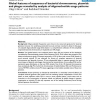Free Online Productivity Tools
i2Speak
i2Symbol
i2OCR
iTex2Img
iWeb2Print
iWeb2Shot
i2Type
iPdf2Split
iPdf2Merge
i2Bopomofo
i2Arabic
i2Style
i2Image
i2PDF
iLatex2Rtf
Sci2ools
BMCBI
2004
2004
Global features of sequences of bacterial chromosomes, plasmids and phages revealed by analysis of oligonucleotide usage pattern
Background: Oligonucleotide frequencies were shown to be conserved signatures for bacterial genomes, however, the underlying constraints have yet not been resolved in detail. In this paper we analyzed oligonucleotide usage (OU) biases in a comprehensive collection of 155 completely sequenced bacterial chromosomes, 316 plasmids and 104 phages. Results: Two global features were analyzed: pattern skew (PS) and variance of OU deviations normalized by mononucleotide content of the sequence (OUV). OUV reflects the strength of OU biases and taxonomic signals. PS denotes asymmetry of OU in direct and reverse DNA strands. A trend towards minimal PS was observed for almost all complete sequences of bacterial chromosomes and plasmids, however, PS was substantially higher in separate genomic loci and several types of plasmids and phages characterized by long stretches of non-coding DNA and/or asymmetric gene distribution on the two DNA strands. Five of the 155 bacterial chromosomes have anomalous...
| Added | 16 Dec 2010 |
| Updated | 16 Dec 2010 |
| Type | Journal |
| Year | 2004 |
| Where | BMCBI |
| Authors | Oleg N. Reva, Burkhard Tümmler |
Comments (0)

